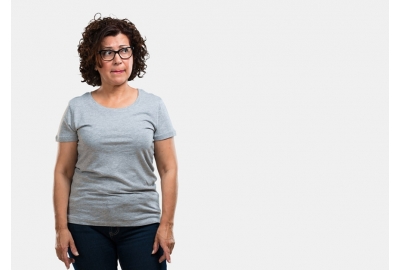
Is Incontinence a Normal Part of Aging?
Once you never had to worry about urinating when you didn’t mean to. But as you’re getting older, you might find yourself experiencing bladder leakage more and more. While incontinence does become more common as you age, it isn’t an inevitable part of aging. Read on to get the facts about incontinence aging, and to learn more about how you can treat incontinence.

By Asier Romero / Shutterstock.com
Is Incontinence a Normal Part of Aging?
About half of older women, or 46 percent, report experiencing incontinence, according to the National Poll on Healthy Aging. It’s slightly less common for younger seniors than older ones: 43 percent of women ages 50–64 report experiencing incontinence, while 51 percent of those ages 65–80 say the same. However, only 34 percent of women experiencing incontinence said that they had actually talked to their doctor about it.
Incontinence can occur as you age because the pelvic muscles become weakened and your control over them can be reduced. In particular, having given birth vaginally increases your risk for incontinence later in life because it stretches those pelvic muscles so much. However, you can develop incontinence without having given birth before.
Learn How Pelvic Floor Exercises Can Strengthen Your Muscles
Just because so many women report experiencing incontinence does not mean that it is a normal part of aging, or that you shouldn’t take steps to address it, especially if it’s impacting your quality of life. Whether your incontinence is occasional or happens every day, you deserve to live a leak-free life full of confidence — and that starts with talking to your doctor.

By Monkey Business Images / Shutterstock.com
Diagnosing Your Incontinence
Your doctor will first work with you to determine the cause of your incontinence. In some cases, the incontinence will be caused by an underlying health problem, such as a UTI. However, for many women, incontinence is the problem. There are two main types of incontinence in aging women: stress incontinence and urge incontinence.
Stress incontinence is very common among older women. This type of bladder leakage occurs when physical activity — such as running, jumping, sneezing, or coughing — puts pressure on the bladder muscles and causes some urine to leak out. You might also experience urge incontinence, which occurs when you have the overwhelming urge to urinate and can’t make it to the bathroom to relieve yourself in time. Some people also have mixed incontinence, or multiple types of incontinence at once.
What to Do If You’re Peeing When Coughing
What to Do About Incontinence
Once your doctor determines what is causing your incontinence, they will make recommendations for treating it. Many of the usual approaches take time to work, so you may want to wear pads or underwear for bladder incontinence to keep you dry and comfortable in the meantime.
See Our Options for Underwear for Bladder Incontinence
Here are some potential treatments that might help with your incontinence:
- Watching your fluid intake will ensure that you stay hydrated without drinking so much excess water that you have to take too many trips to the bathroom
- Avoid common incontinence triggers, such as alcohol, caffeine, and spicy foods
- Take steps to prevent or remedy constipation, which puts pressure on your bladder and makes incontinence worse
- Pelvic floor exercises will strengthen weak bladder muscles and help with involuntary leakage
- If you have stress incontinence, try to avoid or limit activities that you know trigger your bladder leakage
- Bladder training can help manage urge incontinence and teach your body to use the restroom at more regular intervals
- Fully empty your bladder before physical exercise, an important event, or going to bed to minimize the chances of leaks
- Taking certain medications, such as oxybutynin and tolterodine, can help manage bladder leakage as well
In cases of more persistent incontinence, a vaginal insert called a pessary may be used to physically support the muscles and relieve pressure on the bladder. If your bladder muscles spasm involuntarily, causing leakage, Botox injections can be used to help calm them down. Finally, in cases of most extreme incontinence, neurological stimulation devices or surgical procedures may be used. However, most cases of incontinence respond very well to non-invasive lifestyle changes like those outlined above.

When it comes to incontinence, you have enough to focus on without worrying about where you will buy your bladder leakage pads. At Sofia & Grace, we sell a wide range of incontinence products for women to suit all needs and budgets, and you’ll get free shipping on all U.S. orders over $40, discreet packaging included. If you’re not sure what you need, take our incontinence products quiz and get your first two weeks for only $2.99!
Shop Our Entire Collection of Incontinence Products for Women